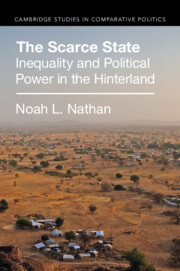Book contents
- Frontmatter
- Contents
- Figures
- Maps
- Tables
- Acknowledgments
- Part I: Introduction
- 1 The Politics of State Scarcity
- 2 The Large Effects of Scarce States
- 3 Northern Ghana’s Scarce State
- Part II: Societal Effects
- 4 The Origins of Inequality
- 5 Bottom-Up Responses to Scarcity
- Part III: Political Effects
- 6 Dynasties
- 7 Invented Chiefs and Distributive Politics
- 8 Nonstate Violence as a State Effect
- Part IV: Extending the Argument
- 9 Shadow Cases
- 10 The Paradox of State Weakness
- Appendix: Qualitative Interviews
- References
- Index
- Other Books in the Series
5 - Bottom-Up Responses to Scarcity
Published online by Cambridge University Press: 23 February 2023
- Frontmatter
- Contents
- Figures
- Maps
- Tables
- Acknowledgments
- Part I: Introduction
- 1 The Politics of State Scarcity
- 2 The Large Effects of Scarce States
- 3 Northern Ghana’s Scarce State
- Part II: Societal Effects
- 4 The Origins of Inequality
- 5 Bottom-Up Responses to Scarcity
- Part III: Political Effects
- 6 Dynasties
- 7 Invented Chiefs and Distributive Politics
- 8 Nonstate Violence as a State Effect
- Part IV: Extending the Argument
- 9 Shadow Cases
- 10 The Paradox of State Weakness
- Appendix: Qualitative Interviews
- References
- Index
- Other Books in the Series
Summary
This chapter explores how scarce states can also reshape hinterland society indirectly by incentivizing society to change itself. My main focus is a modern-day attempt to invent chieftaincy institutions from scratch among the largest “never recognized” ethnic group, the Konkomba. I track the creation of Konkomba chieftaincy over time, concluding with a theoretical discussion of how the state’s scarcity incentivized Konkomba communities into action.
- Type
- Chapter
- Information
- The Scarce StateInequality and Political Power in the Hinterland, pp. 135 - 166Publisher: Cambridge University PressPrint publication year: 2023

